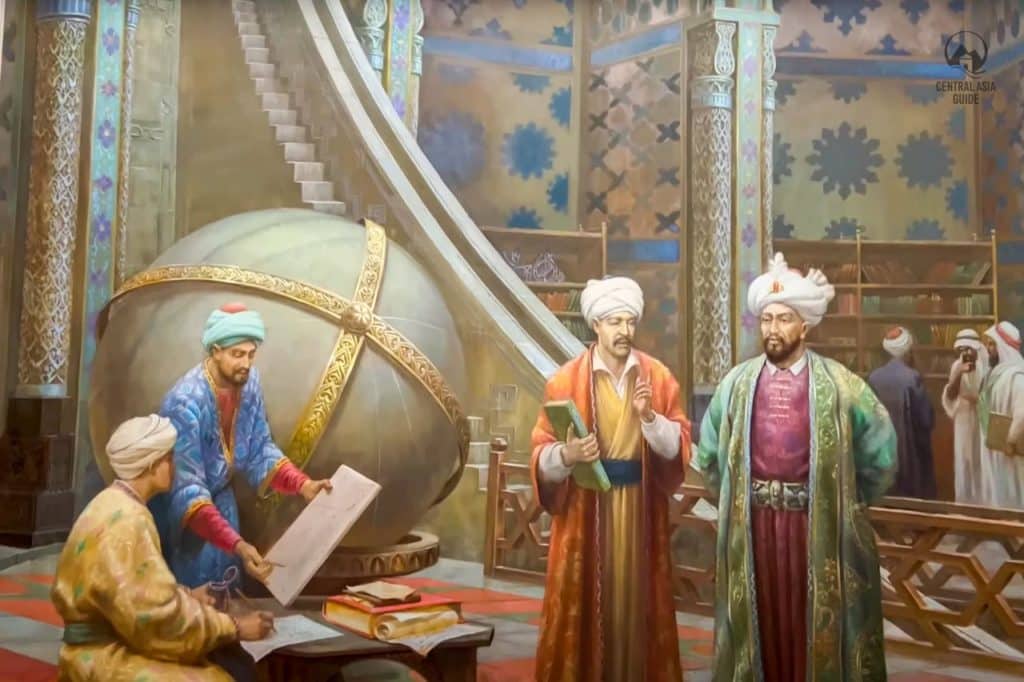Ulugh Beg Observatory
Ulugh beg - Astronomer and Mathematician
Central Asia has seen many rulers who left large footprints on the sands of the history, but Ulugbek will forever remain in the memory of the Central Asian peoples, not only as of the grandson of Tamerlane but also as one of the greatest scholars of Central Asia as he left large footprints on the sands of history.
Ulugbek’s real name is Muhammad Tarag’ay, he was born on 22 March 1394 in a family of Amir Timur’s youngest son Shahrukh. Since the very infancy, Ulugbek was placed under the care of Timur’s favorite wife Saray Mulk Khanum. It had been a regular practice of the Timurid era so that the parents would not spoil their children. Ulugbek was one of the few Timurid princes who took part in the campaigns of his great grandfather. Most of the time he spent there was in the wagon-train and not with the army, but the grandchildren often visited Timur, who closely monitored their education and upbringing.
Since the early ages, Ulugbek showed great talent in the sciences, thus being different from other Timurid princes. During one of the campaigns, Timur’s army visited the city of Maragheg with the ruins of an ancient al-Tusi observatory. The visit of the ruins greatly influenced Ulugbek, who found himself interested in astronomy from then on. A few years after the death of his grandfather, by the decision of his father Shahrukh, Ulugbek became the ruler of Transoxiana.
He launched the construction of madrasahs in Samarkand, Bukhara and Gijduvan. Ulugbek constantly encouraged people to get knowledge, believing that everyone should be educated. During his rule, Central Asia experienced a second period of the Eastern Renaissance.

In 1428 the governor fulfilled his dream: the construction of Ulugbek observatory was completed. Such famous astronomers of the time as Qadi-Zada al-Rumi, al-Kashi, Ali Qushji worked with the outstanding scientist in his observatory. In 1444 Ulugbek finished the main work of his life Zij-i Sultani (Zij astronomical table and star catalog), that was later translated into European languages and became the basic astronomy guidebook all the world. In the history of astronomy, Ulugbek is ranked in par with Copernicus, Galileo, and Ptolemy. Today, there are streets, a district and a metro station in Tashkent named after the great astronomer. Ulugbeg Observatory is included in many of our Uzbekistan Tours and Central Asia Tours.
Ulugbek Observatory
Ulug Beg’s Observatory is one of the largest astronomical observatories built in the 1420s lie in a ten-minute walk from Afrosiab. For almost three decades, scholars, including the outstanding astronomers Qazi-Zadeh Rumi, Djemsnid Giyas ad-Din Kashi and Ali Kushchi, performed measurements of celestial movements here. The Samarkand observatory became famous for the edition of the “Ulugbeg Zidj”, holding a theoretical introduction and charts describing 1,018 stars.
The arc is dropped below ground, which is the reason it survived when the rest of the observatory was destroyed by fanatics in 1449. The observatory was found by Samarkand archeologist V. L. Vyatkin at the beginning of the 20th century. He excavated the underground remains of a huge quadrant 40 m in radius which was used for the observation of the Sun, Moon and other celestial bodies.

Today visitors can view his discovery, the underground part of a vast meridian arc. It is a quadrant arc 63 m in length and it was used to chart the progress of celestial bodies across the sky. Using this arc, Samarkand’s medieval astronomers produced a star catalog charting the movements of 1018 stars, which is still known and was studied in Oxford in the 17th century. It was the largest 90° quadrant the world had ever seen, though it is called a sextant as only 60° were used. Deeply embedded in the rock to lessen seismic disturbance, the surviving 11-meter arc sweeps upwards in two marble parapets cut with a minute and degree calibrations for the astrolabe that ran its length. The arc completed its radius at the top of a three-story building.
Descend into the dark, and you will see the scale of the arc but also the accuracy with which it was made, tiny niches are cut into the surface for calibrating the once-accompanying astrolabe, enabling exact calculations to be made. In fact, their accuracy would not be beaten until the invention of the computer. Above ground floor located service rooms were arcades designed as astronomical instruments. A spectator described the planetarium-like decoration: ‘Inside the rooms, he had painted and written the image of the nine celestial orbits and the shapes of the nine heavenly bodies, and the degrees, minutes and seconds of the epicycles; the seven planets and pictures of the fixed stars, the image of the terrestrial globe, pictures of the climes with mountains, seas and deserts.
Tours including Ulug-Beg Observatory
Sights near Ulugbek Observatory
Page updated 15.7.2021